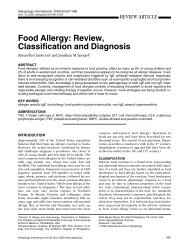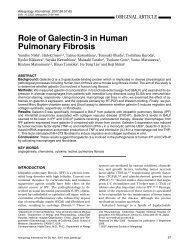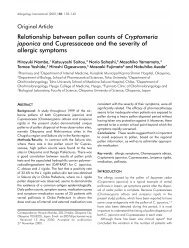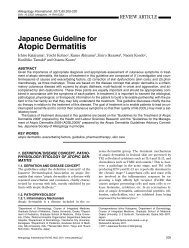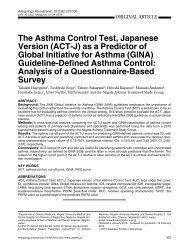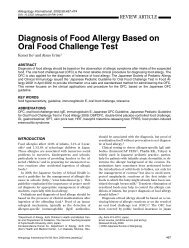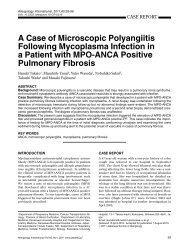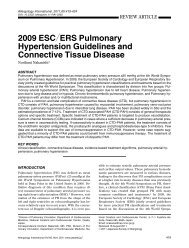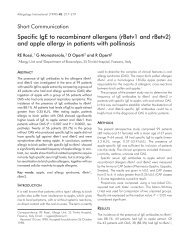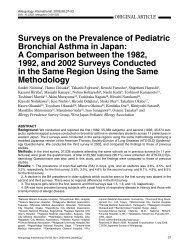Therapeutic Guidelines for Atopic Dermatitis 2002 - Allergology ...
Therapeutic Guidelines for Atopic Dermatitis 2002 - Allergology ...
Therapeutic Guidelines for Atopic Dermatitis 2002 - Allergology ...
You also want an ePaper? Increase the reach of your titles
YUMPU automatically turns print PDFs into web optimized ePapers that Google loves.
<strong>Therapeutic</strong> <strong>Guidelines</strong> <strong>for</strong> <strong>Atopic</strong> <strong>Dermatitis</strong> <strong>2002</strong>DiagnosisEvaluation of SeverityEducation and Avoidance ofTrigger and Aggravating FactorsSkin Care(compensation <strong>for</strong> the functionalabnormalities of the skin)MedicationsFig.1 Principles<strong>for</strong>therapyInfantile(less than 2 years old)Childhood(2 to 12 years old)Adolescence and Adult(13 years old and older)FoodsSweatingEnvironmental factorsBacteria, fungietceteraEnvironmental factorsSweatingBacteria, fungiContact allergensStressFoodsetceteraBecause the trigger and aggravating factors vary among patients, it is important to carefullyelucidate the trigger and aggravating factors be<strong>for</strong>e recommending their avoidance.Fig.2 TriggerandAggravatingFactorsTable2 GlobalClinicalSeverityMildModerateSevereVerySevere:Beingcoveredwithmildskinlesions*only,irespectiveofbodysurfaceareaafected:Inflamed skin lesions*covering lessthan10% ofthebodysurface:Inflamed skin lesions covering morethan 10% butless than 30% ofthebodysurface:Inflamed skin lesions covering morethan30% ofthebodysurface*Mildskinlesions:Dryskin,scalingandfainterythema.*Inflamed skin lesions:Lesionswith erythema,papules,erosion,infiltration,lichenification,andsoon.maintenance, decreased threshold of itch sensationand tendencies toward bacterial and viral infections.It is known that these abnormalities are strongly relatedto the development of symptoms and aggravationof dermatitis. Suitable skin care is there<strong>for</strong>e requiredto compensate <strong>for</strong> these abnormalities (Table3).MEDICATIONSuitable medication is required to control cutaneousinflammation . Topical steroids and oral antihistamineanti-allergic drugs are the mainstay oftreatment of AD. Figure 3 shows fundamental topicalsteroid therapy according to severity grading in patientsless than 2 years old, 2 to 12 years old, and 13years old or older. Table 4 shows a classification ofthe potency of topical steroids. The following pointsare important <strong>for</strong> drug treatment. We must select thepotency and vehicle <strong>for</strong>mulation of topical steroids accordingto the patient’s age and distribution andmanifestation of each eruption. We recommend thatgeneral physicians prescribe topical steroids of lowerpotency and smaller volume and <strong>for</strong> as short a periodof time as possible <strong>for</strong> facial lesions to reduce the occurrenceof adverse effects. The adverse effects oftopical steroids, such as teleangiectasia and skin atrophy,occur more frequently with longer periods of application.Physicians must monitor the potency anddosage of topical steroids <strong>for</strong> their patients. 2 If a patientsuddenly stops the application of topical steroids,the eruptions may exacerbate rapidly . Physiciansshould ask their patients to tell them when they<strong>Allergology</strong> International Vol 54, No1, 2005 www.js-allergol.gr.jp 47



